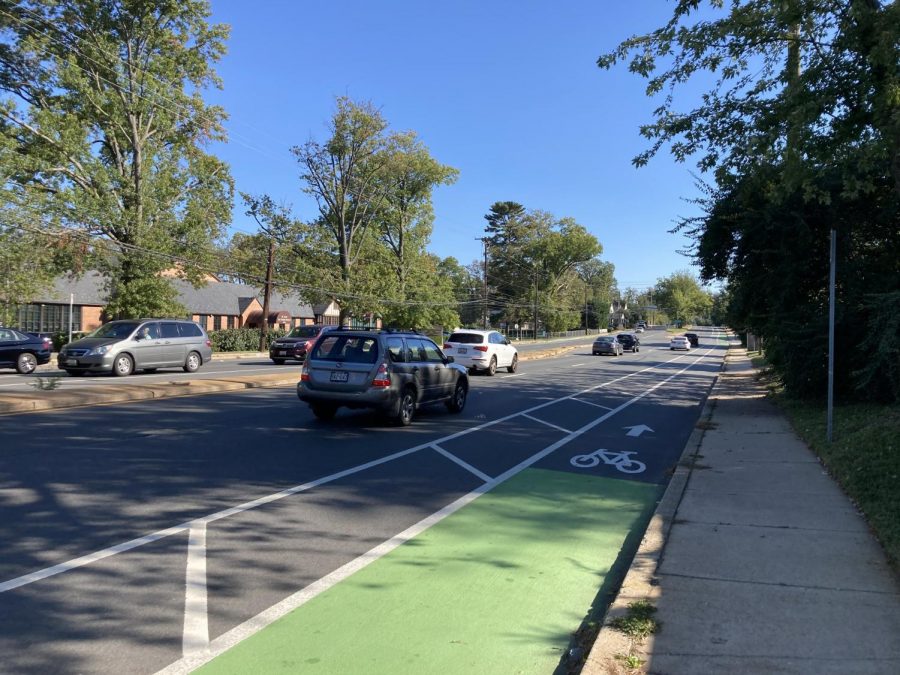For years, residents, county leaders, and state officials had pointed to data showing the dangers of Old Georgetown Road and calling for improvements. The chorus grew louder after University of Maryland student Enzo Alvarenga was fatally struck by a van in June, just north of where another teen bicyclist had been killed three years prior.
In fact, the State Highway Administration had already decided to convert one lane of motor vehicle traffic in each direction into a bike lane, from just south of the Capital Beltway north to Nicholson Lane. This fall, crews resurfaced much of the roadway in North Bethesda, narrowed lanes, planted flexposts along the bike routes, and installed high-visibility crosswalk markings at many intersections.
Now neighbors and commuters are criticizing the project as poorly conceived, confusing and dangerous, and have launched an online petition to revisit the change. They say, yes, bicyclists need their own lanes—but not like this.
“Do I believe there should be more bike paths? Sure, I think that people should be able to ride their bike safety,” said Allan Ginsburg, who has lived in North Bethesda for more than four decades. “But I don’t think that should take away from [existing] traffic patterns, that [then] create more traffic and more danger.”
Earlier this month, he took his criticism to the NextDoor social platform in a post that had drawn nearly 900 comments as of Monday evening. Ginsburg, a member of the Luxmanor Citizens Association, said that the project was an example of poor engineering and strategic planning by county and state officials. He believes the new design has created more traffic — and that the roadway isn’t actually safer for people who aren’t driving a car.
The discussion echoes others in the county in recent years, as state and county roads officials have rolled out more bike-friendly infrastructure, both temporarily (last year, along University Boulevard) and permanently (in downtown Bethesda), much of it in keeping with the county’s Bicycle Master Plan, adopted in 2018.
The Maryland State Highway Administration (SHA) said that the project was completed after a comprehensive Corridor Needs Analysis for Old Georgetown Road between McKinley Street in Bethesda and Tilden Lane/Nicholson Lane in North Bethesda was completed. They say the changes are meant to make the roadway safer for all users: motorists, bicyclists, walkers and those catching a bus along Old Georgetown Road.
“MDOT SHA engineers design a transportation system that considers all road users, not just motorists,” Shantee Felix, an SHA spokesperson, wrote in an email. “Consideration needs to be given to vehicle speed, adequate pedestrian facilities, potentially distracted drivers, and adequate lighting, to name a few.”

Officials have for years pinpointed Old Georgetown as high-risk. The county Planning Department’s Interactive Crash Map notes that “Most serious injuries and fatalities are located along the county’s arterials, such as Georgia Avenue, Old Georgetown Road, and Veirs Mill Road.”
Supporters of the bike lanes say they are a much-needed improvement to the corridor, especially as there have been fatal bicycle accidents in recent years. That includes Alvarenga, a University of Maryland student who died after being hit by a van while riding his bike along a sidewalk on Old Georgetown Road, then fell into the roadway to avoid a branch this summer. Another bicyclist, 17-year-old Jacob Cassell, was fatally struck on the roadway in 2019.
The Corridor Needs Analysis noted that 338 crashes were reported between 2014 and 2018, with pedestrians and bicyclists having an outsize risk of severe injury. “Of these crashes, 65 were severe, disabling, or fatal; 18 of these crashes involved a person walking or biking, of which 14 individuals walking or biking were injured or disabled. In total 5% of crashes along the study area involved a person walking or biking (18 crashes), and 77% of those crashes resulted in an injury for the pedestrian or bicyclist.”
County data show that so far this year, four bicyclists and 14 pedestrians count among the 49 people killed in 45 fatal motor vehicle crashes in the county.
But opponents of the changes believe that state highway officials did not consider the additional traffic that the buffered bike lanes would create, and the ensuing confusion between motorists, bicyclists and other roadway users.
According to the Nextdoor post posted by Ginsburg, many residents who live near the area said that their commute times have increased by at least 20 to 30 minutes. Many also expressed concerns that right-hand turns would become more dangerous, as motorists would turn into the path of bicyclists who are using the new lanes.
State highway officials say that the data that goes into projects like the buffered bike lanes and resurfacing project include “roadway capacity, local [resident] input, potential bicyclist activity, transit facilities, regional Context, safety, mobility benefits, and others.”
Peter Gray, a member of the Washington Area Bicyclist Association, has joined other bicycle and transportation advocates in support of the change. Gray and others say that the focus should first be on making the corridor safer for non-motorists, before considering the speed of traffic or how long it takes drivers to get from one place to another. Although he doesn’t live in North Bethesda, he has used the lanes on Old Georgetown Road.
There are always growing pains for everybody when new infrastructure is put into a heavily traveled corridor, Gray said. That can include confusion among drivers, he added. But there have been examples of how bicycles and other roadway users can share the road — including along Beach Drive in parts of Bethesda and toward Silver Spring, he said.
“I think the same thing can and will happen if the bike lanes are allowed to remain on Old Georgetown Road. The cars will be more conscious of the fact that bicycles are traveling parallel to them, and they have to make sure not to make a turn and crash into a cyclist,” Gray said. “I also think that just the fact that those flexposts are there, it is going to have the positive impact of slowing the cars down to the posted speed limit.”
SHA officials have said the buffered bike lanes are a “permanent solution” for bikers along Old Georgetown Road. In September, they met with local residents, and county and state leaders for a walk along the roadway, to examine what changes need to be made.
According to a Corridor Needs Analysis completed by SHA officials, other long-term solutions include improving red light signal timing and operations at multiple intersections along Old Georgetown Road, installing red light and speed cameras, and modifying street corners in order to prevent fast turns at intersections.
Del. Marc Korman (D-Dist. 16), whose district includes the Old Georgetown Road bike lanes, said in an email that he has asked SHA officials for a post-installation study to see the project’s impact on traffic times, pollution, and car crashes.
Korman said he shares the community’s concerns about traffic impacts.
“I think the traffic projections and the reality of the impact on traffic are mismatched,” Korman wrote. “Most people do not mind a minute or two increase in travel time but when travel times are being doubled (or more), that’s obviously a different situation. There are certainly other issues that have been raised and should be considered, but I think most of the concern, understandably, relates to the dramatic increase in travel times that anyone driving along the road has experienced.”
Korman added that users of the corridor want a safer roadway, but added that a balance must be reached on how Old Georgetown Road is reconfigured.
“Motorists don’t want cars banned from the road; pedestrians don’t want pedestrians banned from the road; and bicyclists don’t want bicycles banned from the road. Each of those may make the road ‘safer,’ but would be unacceptable to essentially everyone. So instead of such an extreme, there needs to be a balance.”
Source : Bethesda



























